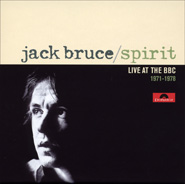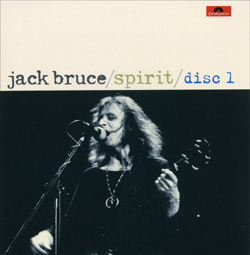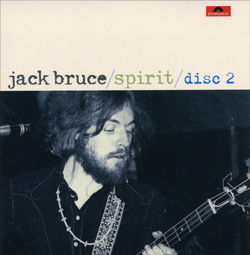
Jack Bruce
Spirit
(Polydor)
Subtitled Live At The BBC 1971-1978, Spirit (the name of a Tony Williams
composition which here gets performed twice, with quite different readings)
is a compact mini-box which is said to feature all the available material
from what Jack Bruce recorded for broadcasting purposes for the British
radio station in the course of that decade. About two-thirds of the most
relevant material featured here (there are also some unusual performances
of a jazz-like nature – not really indispensable, but not really without
merit, either – about which I’ll talk in a short while) had already been
made available about ten years ago in two separate CDs, so it’s quite likely
that every self-respecting Jack Bruce fan already owns them; but in my
opinion, the new mastering job (compared to the previous version, this
one sounds quite clearer, though it goes without saying that nothing can
really perform any miracles on the sound of the original tapes); the useful
liner notes; the long, previously unreleased track performed by the Mick
Taylor/Carla Bley line-up; the unreleased concert by the group featuring
Tony Hymas and Simon Phillips; are all elements that will make the real
fan decide to buy the thing.
‘Cause
it is quite obvious that those who will be most intrigued by the box will
be those who already know the story quite well, and so can really appreciate
these new (minor) revelations. Which doesn’t mean that the music that’s
featured in the box can’t stand on its own, or can’t be appreciated as
a self-sufficient aesthetical experience; but I really think that, in order
to fully appreciate its meaning – i.e., what’s different and what’s similar,
and the way the material was changed by musicians of different styles,
while at the same time imposing its own peculiar logic on them – a very
intimate familiarity with the original albums is required.
But
what about all those who have never heard anything by Jack Bruce (here
I’m gonna limit myself to his solo albums only, with no mention of groups,
collaborations and special appearances)? On paper, nothing could be simpler:
it’s enough that one gets the albums titled Songs For A Tailor (1969),
Harmony Row (1971), and Out Of The Storm (1974), with maybe How’s Tricks
(1977) to follow. Those albums were re-released just a few years ago, by
the way, with booklets featuring informative liner notes, photos, lyrics,
bonus tracks, and a digital sound that for once didn’t make one long for
the original. In practice, things are not quite that simple, for various
reasons that – as time goes by – make it increasingly difficult for one
to fully understand works like those by Bruce (but it’s obvious that here
I could mention many other names, as well).
Once
a precious resource to make one go beyond narrow horizons, later rejected
for reasons that even those who did the rejecting didn’t fully understand,
instrumental virtuosity is nowadays just a mysterious entity; nor is it
any easier to get innovation as a part of the framework of the norm, since
it’s the notion of norm itself that’s increasingly become difficult to
be perceived; just as is the case with the desire for change in music as
a self-propelling factor.
Bruce’s
Romanticism has always been of the hard kind; his musical output being
the outcome of a very complex background; now let’s add his being a multi-instrumentalist,
and a virtuoso on the electric bass that has few equals in the history
of rock; also a very personal, not to mention versatile, voice. (His solo
recorded output is one that I’ve always thought John Greaves had on his
mind when he started his solo career, post-Henry Cow.)
This
tiny box comes with three CDs, each featuring about 1h. from a live concert,
plus about 15′ of the aforementioned jazz material, performed by a trio,
from a different source. A strange thing in the graphics dept. is that,
while concerts featured on CDs 1, 2, and 3 date from years 1971, 1975 and
1977, the pictures on the corresponding CD covers show a Bruce from 1974,
one (bearded) from 1970, and one from 1971!

The
first CD features a concert of the line-up that Bruce assembled in order
to perform material coming mostly from his then-new album Harmony Row.
Logically enough, he retained those musicians who had so greatly contributed
to the album’s artistic success: Chris Spedding on guitar, John Marshall
on drums; the former with his "apparent simplicity" that at the
time made him a favourite of many; the latter being versatile and agile,
at his best. On Hammond organ, piano and alto sax, for the most part Graham
Bond performs those instrumental parts that Bruce himself had overdubbed
in the studio. The second part of the concert has Art Theman ebulliently
performing on tenor sax, sounding at times quite similar to Gary Windo’s.
Fantastic bass work by Bruce, also his vocals.
As
expected, quite a few songs come from Harmony Row: You Burned The Tables
On Me, Smiles And Grins, Folk Song, A Letter Of Thanks. We also have, coming
from Cream’s repertory, We’re Going Wrong. The Clearout is off Songs For
A Tailor. After a relatively concise first part, the concert goes in a
bluesy, controlled-jam-session, direction: Have You Ever Loved A Woman?
is sung by Bond. Powerhouse Sod and You Sure Look Good To Me follow.

The
second CD features a concert by the Jack Bruce Band, with Mick Taylor on
guitar, Carla Bley on keyboards, Bruce Gary on drums, and Ronnie Leahy
on more keyboards. This is beautiful, stimulating material: Can You Follow?,
Morning Story and Smiles And Grins come from Harmony Row; while the complex,
fractured tracks Keep It Down, Pieces Of Mind and One are from the at the
time recently released Out Of The Storm. Spirit by Tony Williams gets a
nice treatment, just like Without A Word, which was then an unreleased
track: it’s the track that, and I don’t really know why, was missing from
the version of this concert that had been previously released on CD.
As
I’ve already written elsewhere, the weak link here is Mick Taylor: he’s
quite good when the scale is (as similar as possible to the) blues, while
in different climates he doesn’t sound as sure of himself (and check the
"Santana chord" he uses in order to make Keep It Down sound
"funky"). Gary is agile and versatile, while Leahy and Bley share
the keyboard work quite intelligently: the former on acoustic, also Fender
Rhodes, piano; the latter on Hammond organ and Mellotron. This version of
Without A Word is a nice discovery: whereas the studio version recorded by
this group – unavailable until it was added as a bonus track to the new edition
of the album How’s Tricks – is nothing special, here its long duration, and
its long, nice solos make for a very nice track.

The
third CD has the How’s Tricks line-up performing a large portion of that
album, with some added material. Tony Hymas is an excellent orchestrator,
and his keyboard work (on Hohner Clavinet, Fender Rhodes, monophonic ARP
Odyssey, and ARP String Ensemble, I think) is good. Simon Phillips is an
agile and precise drummer (sometimes, maybe a bit too much); while on guitar,
Hughie Burns doesn’t have much personality. All the material off How’s
Tricks is ably performed (here the real problem is whether one likes it
in the first place), the added material making for a nice change: Spirit
(but this version has no real sparkle); Born Under A Bad Sign, a track
that Cream had already performed on record; Out Into The Fields, coming
from Why Dontcha, the first album by West, Bruce & Laing; You Burned
The Tables On Me.
Those
jazz sessions I referred to above come from a BBC Radio 3 program titled
Jazz In Britain; all are performed by a trio featuring Jack Bruce on electric
and acoustic bass, John Surman on soprano and baritone sax, and John Hiseman
on drums; three tracks recorded in 1971 appear on the first CD, we also
have three tracks from 1978: two are featured on the second CD, with the
third track appearing on the third CD. It’s a nice bonus, but it won’t
be the reason people will buy the box. The rhythm section is not bad at
all, while Surman is at his best on baritone sax, his playing on soprano
sounding quite prolix.
Beppe Colli
© Beppe Colli 2008
CloudsandClocks.net | Apr. 10, 2008


